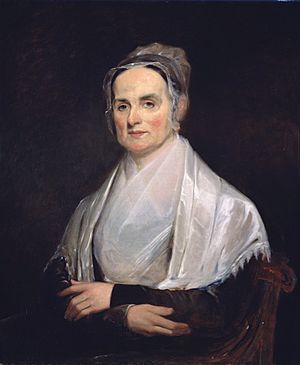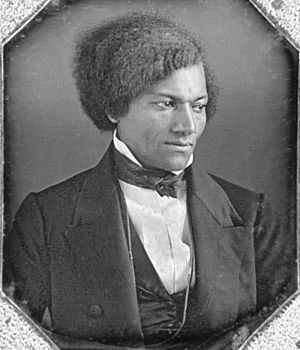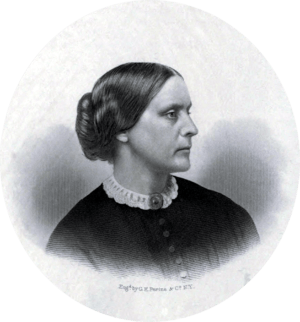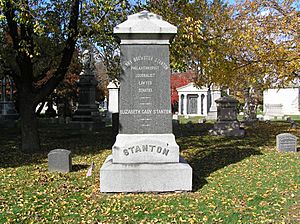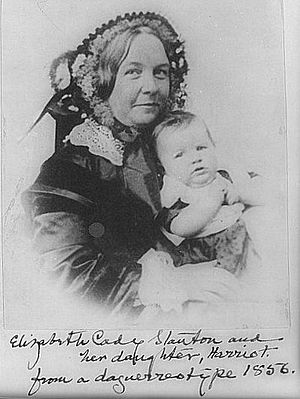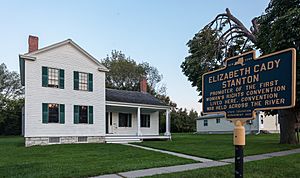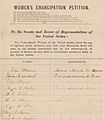Elizabeth Cady Stanton facts for kids
Quick facts for kids
Elizabeth Cady Stanton
|
|
|---|---|
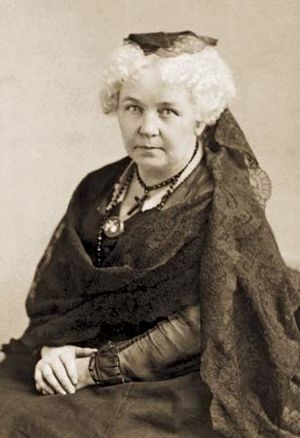
Stanton, c. 1880, age 65
|
|
| Born |
Elizabeth Cady
November 12, 1815 Johnstown, New York, U.S.
|
| Died | October 26, 1902 (aged 86) New York City, U.S.
|
| Resting place | Woodlawn Cemetery, New York City, U.S. |
| Occupation |
|
| Spouse(s) | |
| Children | 7, including Theodore and Harriot |
| Parent(s) | Daniel Cady Margaret Livingston |
| Relatives | James Livingston (grandfather) Gerrit Smith (cousin) Elizabeth Smith Miller (cousin) Nora Stanton Barney (granddaughter) |
| Signature | |
Elizabeth Cady Stanton (born November 12, 1815; died October 26, 1902) was a very important American writer and activist in the women's rights movement in the United States during the 1800s. She is famous for helping to organize the first convention focused on women's rights and for demanding that women should have the right to vote.
Contents
Early Life and Education
Elizabeth Cady was born on November 12, 1815, in Johnstown, New York, into a wealthy and influential family. Her father, Daniel Cady, was a lawyer and judge who even served in the U.S. Congress. Her mother, Margaret Cady, was more open to new ideas, like supporting the movement to end slavery. Elizabeth was one of many children, but sadly, many of her siblings did not live to be adults.
Unlike many girls at the time, Elizabeth received a good education. She attended Johnstown Academy, where she studied subjects like math and languages, even competing with boys. She was a skilled debater.
A moment that deeply affected her was when her last surviving brother died. Her father, in his grief, said he wished she had been a boy. This showed her how society valued boys more than girls. She wanted to go to college, but colleges didn't accept women back then. She ended up attending the Troy Female Seminary, a school for girls founded by Emma Willard.
Becoming an Activist
Elizabeth's cousin, Gerrit Smith, was a strong supporter of ending slavery. Visiting his home, she met many people who were working for social change, including Henry Brewster Stanton, a leading figure in the movement to abolish slavery. Elizabeth married Henry Stanton in 1840. They decided to leave out the word "obey" from their marriage ceremony, which was unusual at the time but showed her belief in equality in marriage. She chose to use her own name, Elizabeth Cady Stanton, rather than just being known as "Mrs. Henry B. Stanton."
While on their honeymoon in London in 1840, the Stantons attended a large meeting about ending slavery. Elizabeth was upset when the men at the convention voted to prevent women who were delegates from participating fully, making them sit in a separate area. This experience, along with meeting other women activists like Lucretia Mott, helped focus her energy on fighting for women's rights.
Living in Seneca Falls, New York, and raising a family, Stanton felt limited by the traditional roles for women. She felt a strong need to take action to improve women's lives. In the summer of 1848, she met up with Lucretia Mott and other women. They decided to organize a convention to discuss women's rights. This meeting, held just a few days later in Seneca Falls, became a landmark event.
Stanton was the main writer of the document presented at the convention, called the Declaration of Rights and Sentiments. It was written like the U.S. Declaration of Independence but listed the ways women were treated unfairly.
One of the most debated ideas in the Declaration was Stanton's demand for women's right to vote. Many people, even some who supported women's rights, thought this was too radical at the time. However, with support from people like Frederick Douglass, who had escaped slavery and was a powerful speaker, the idea was approved at the convention.
The Seneca Falls Convention was the first public meeting held specifically to discuss women's rights. It brought attention to the movement and the Declaration of Sentiments became a key document, helping to spread the idea of women's rights across the country.
Partnership with Susan B. Anthony
In 1851, Elizabeth Cady Stanton met Susan B. Anthony, who was also working for social reform. They quickly became close friends and partners in the women's rights movement. Stanton was a brilliant writer and thinker, coming up with ideas and powerful words. Anthony was an amazing organizer and speaker, traveling the country to give speeches and gather support. They worked together for decades, with Stanton often writing speeches for Anthony to deliver.
Their partnership was incredibly important to the growth of the women's rights movement. Stanton provided the vision and arguments, while Anthony handled the practical work of building the movement. They were often described as a perfect team, with Stanton forging the ideas and Anthony putting them into action.
Working for Change
Stanton and Anthony were also involved in the temperance movement, which aimed to reduce or stop the use of alcohol. They helped start a women's temperance society, with Stanton as president.
Stanton also worked to change laws that treated married women unfairly. Under old laws, a married woman's property was controlled by her husband. Stanton's father, a lawyer, even supported changing these laws partly because he didn't want his wealth to be controlled by his daughters' husbands. New York passed laws in 1848 and 1860 that gave married women more control over their own property. Stanton argued that women needed the right to vote to protect these new rights.
Dress reform
For a time, Stanton wore a new style of dress called "Bloomers," which included trousers under a shorter dress. This was much more practical than long, heavy dresses, especially for women with active lives. However, it caused a lot of controversy and made people focus on the clothing instead of women's rights, so Stanton and others eventually stopped wearing them publicly.
Divorce reform
Stanton believed that marriage should be a partnership and that women should have the right to end a marriage if it was harmful or unhappy. This was a very controversial idea at the time, as divorce was difficult to get and often looked down upon. She argued that women needed legal ways to leave unhealthy situations.
The Civil War and After
Stanton and Anthony were strong supporters of ending slavery. During the Civil War, they formed the Women's Loyal National League to campaign for a constitutional amendment to abolish slavery. This group organized the largest petition drive in U.S. history up to that time, collecting nearly 400,000 signatures, which helped support the passage of the Thirteenth Amendment ending slavery.
After the war, when amendments were being added to the Constitution to give rights to African Americans, Stanton and Anthony were upset that the proposed Fourteenth Amendment introduced the word "male," suggesting that only men had the right to vote. They formed the American Equal Rights Association (AERA) to campaign for voting rights for all citizens, regardless of race or sex. Many abolitionists and reformers felt that this was "the Negro's hour" and that they should focus on getting voting rights for black men first. Stanton and Anthony disagreed, insisting that women should also get the right to vote at the same time. This led to a difficult split in the movement. The disagreement led to the formation of two different women's suffrage organizations: the National Woman Suffrage Association (NWSA), led by Stanton and Anthony, which focused on a national amendment and a wider range of women's issues; and the American Woman Suffrage Association (AWSA), which focused on getting the vote state by state and maintained ties with other reform groups.
Later Years and Writings
In 1868, Stanton and Anthony started a newspaper called The Revolution to promote their views on women's rights, especially suffrage. Stanton was a co-editor. The paper covered many topics important to women and had the motto: "Men, their rights and nothing more: women, their rights and nothing less."
Stanton, Anthony, and others worked for many years to write the "History of Woman Suffrage", a massive, multi-volume book documenting the story of the movement. Stanton wrote much of the early volumes.
For about ten years, Stanton traveled the country giving speeches as part of the Lyceum movement, which brought speakers and entertainment to communities. Her lectures covered topics like women's rights, marriage, divorce, and education. This allowed her to share her ideas with many people and also helped her earn money for her family.
In 1890, the two main suffrage organizations, the NWSA and the AWSA, merged to form the National American Woman Suffrage Association (NAWSA). Stanton became the first president, largely at Anthony's urging, although she felt the new group was too focused only on voting rights and not other issues important to women.
In 1895, Stanton published "The Woman's Bible", a book that examined the Bible from a woman's perspective. She argued that many parts of the Bible reflected prejudice against women from older times, not the word of God. This book was very controversial and caused further disagreements within the women's rights movement, with many younger leaders wanting to distance the suffrage movement from her religious views.
In 1892, Stanton gave a famous speech called "The Solitude of Self." In it, she argued that every person, male or female, is ultimately alone in life and must rely on their own strength and abilities. She emphasized the importance of education and self-reliance for women, arguing that they needed to be prepared to stand on their own, regardless of their roles as daughters, wives, or mothers.
Marriage and family
Stanton married Henry Brewster Stanton, a prominent abolitionist agent, in 1840.
The couple had seven children. Stanton encouraged both her sons and daughters to pursue a broad range of interests, activities, and learning. She enjoyed motherhood and running a large household, but she found herself unsatisfied and even depressed by the lack of intellectual companionship and stimulation in Seneca Falls.
Due to Henry's work, the couple very often lived apart, maintaining separate households for several years. Their marriage, which lasted 47 years, ended with Henry Stanton's death in 1887.
Death
Elizabeth Cady Stanton died on October 26, 1902, eighteen years before women in the United States gained the right to vote with the passage of the Nineteenth Amendment in 1920. Remembered: Although some younger leaders in the suffrage movement later downplayed her role because of her controversial views, Stanton is now recognized as one of the most important figures in the history of women's rights in the United States.
Interesting facts about Elizabeth Cady Stanton
- Stanton was a mother to 7 children. Each time she gave birth, a red flag was raised in front of her house for a boy and a white one for a girl.
- One of her daughters, Harriot Stanton Blatch, became, like her mother, a leader of the women's suffrage movement.
- Six of the seven Stanton children graduated from college. Colleges were closed to women when Stanton sought higher education, but both of her daughters were educated at Vassar College.
- Stanton was the primary author of the first three volumes of the History of Woman Suffrage, a massive effort to record the history of the movement, focusing largely on her wing of it.
- She was also the primary author of The Woman's Bible, a critical examination of the Bible that is based on the premise that its attitude toward women reflects prejudice from a less civilized age.
- Two years ahead of her death, Stanton had signed a document directing that her brain was to be donated to Cornell University for scientific study, but her wishes in that regard were not carried out.
Elizabeth Cady Stanton quotes

- "The history of the past is but one long struggle upward to equality."
- "Self-development is a higher duty than self-sacrifice."
- "The best protection any woman can have... is courage."
- "Nothing strengthens the judgment and quickens the conscience like individual responsibility."
- "I am always busy, which is perhaps the chief reason why I am always well."
Legacy
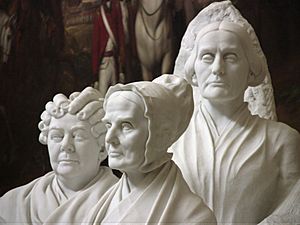
Stanton began to regain recognition for her role in the women's rights movement with the rise of the new feminist movement in the 1960s and the establishment of academic women's history programs.
- She is commemorated, along with Lucretia Mott and Susan B. Anthony, in the 1921 sculpture Portrait Monument by Adelaide Johnson in the United States Capitol. Placed for years in the crypt of the capitol building, it was moved in 1997 to a more prominent location in the U.S. Capitol rotunda.
- In 1965, the Elizabeth Cady Stanton House in Seneca Falls was declared a National Historic Landmark. It is now part of the Women's Rights National Historical Park.
- In 1973, Stanton was inducted into the National Women's Hall of Fame.
- In 1975, the Elizabeth Cady Stanton House in Tenafly, New Jersey, was declared a National Historic Landmark.
- In 2020, the Women's Rights Pioneers Monument was unveiled in Central Park in New York City on the 100th anniversary of the passage of the Nineteenth Amendment giving women the right to vote. Created by Meredith Bergmann, this sculpture depicts Stanton, Susan B. Anthony and Sojourner Truth engaged in animated discussion.
Images for kids
-
A petition to Congress for a women's suffrage amendment signed by Stanton, Anthony, Lucy Stone, Antoinette Brown Blackwell, Ernestine Rose, and other leading women's rights activists
See also
 In Spanish: Elizabeth Cady Stanton para niños
In Spanish: Elizabeth Cady Stanton para niños


